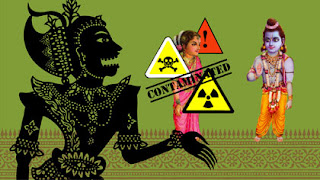Fig. 1. Sita Sings the Blues poster.
Sita Sings the Blues
(2008) is an animated film
created by Nina Paley that amazingly she made by herself, an impressive
accomplishment that would have been a lot of work. It is quite clear that the
film is made by one person with the repetitive animation that happens
throughout the film; however Paley does an excellent job at creating an
eclectic animation that has broad style changes throughout.
Fig. 2. Sita still.
The story was very
interesting as it told two stories juxtaposed that ended in a similar fashion.
One side of the story is about the Ramayana, it focuses on the story of Rama
and Sita which is broadly a story about love and relationship issues. One
second Rama and Sita are happy and in love, the next she is being kidnapped and
then questioned about her purity, while all of this is taking place the second
story mirrors it in the modern day, interestingly the second story is about
Paley and her failed relationship. The personal touch really feels strong
throughout this story and the use of comparing her relationship troubles to
Rama and Sita seems like a very intelligent decision. The film story does a lot
of work to keep you interested, the narrators discussing the story with each
other and having slightly different versions really does make the film feel
more personal and in a sense quite comical.
Fig. 3. Manuscript style still.
The styles change vastly
throughout the film, when the film becomes a musical the characters look extremely
influenced by Betty Boop, they become very cartoony and quite funny to look at.
When it gets a bit more dramatic and the scenes become more serious it changes
to an manuscript painting style, which makes it feel more like an adaptation of
the Ramayana in an informative way, however this doesn’t appear to be the case
as the story seems to be a way of expressing her troubled relationship. In the
modern day Paley used a lot of collage which to me seems like another
intelligent decision, she separates the scenes with different styles so you
know what is happening, how to feel and what to expect. The only downside is
that it could possibly be seen as a bit un-immersive as the constant change to
style breaks the film up a bit.
The film can feel a little
repetitive in times, for example the songs start to become a bit of a chore to
listen to and some of the animation is very repetitive which is completely
understandable as it was all created by one person. This is the only real
negative point as watching the same animation over and over can be quite
draining, for the most part however it wasn’t too bad.
Overall I enjoyed the
film, I felt like it did drag on a bit after a few of the musical numbers
however the overall impression was good. The narrators offered a lot of comic release
and I found it quite funny when they were discussing the story each giving
different versions and names, their opinion about the events was also a very
nice touch that made it feel very personal. I liked the eclectic nature of the
film and thought that it was very clever and precise in executing it, the story
was good and it definitely help hold the film together.
Illustration List:
Figure 1. Sita Sings the
Blues poster. (2008) From: Sita Sings the Blues, Directed by: Nina Paley [Film
still] At: http://sitasingstheblues.com/SitaEPressKit/SitaPosterAgniA2.png
(Accessed 28/01/2016)
Figure 2. Sita still. (2008)
From: Sita Sings the Blues, Directed by: Nina Paley [Film still] At: https://cultureatkamelia.files.wordpress.com/2011/07/sita1.png
(Accessed 28/01/2016)
Figure 3. Manuscript style
still. (2008) From: Sita Sings the Blues, Directed by: Nina Paley [Film still]
At: http://sitasingstheblues.com/SitaEPressKit/BhavanaSitaContaminated.jpg
(Accessed 28/01/2016)




No comments:
Post a Comment